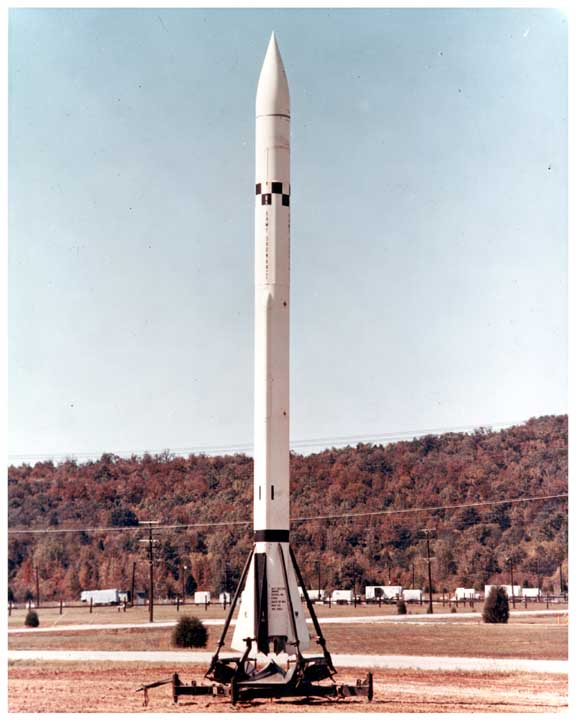Corporal (missile)

Corporal was the first American surface-to-surface missile to approach the capability of the German V-2, the first operational guided missile of the US Army, and the first US guided missile system to be approved for nuclear armament. The liquid-fueled Corporal and the Private stemmed from Project ORDCIT – a long-range missile program begun by the California Institute of Technology's rocket laboratory at the request of Army Ordnance in 1944.
The development began with the Private-A and Private-F, and continued with the WAC Corporal and Corporal-E, before becoming a separate weapons development program. The main contractor for Corporal was the Jet Propulsion Laboratory (JPL); however, the contract for the production of the operational missiles went to Firestone in 1951, after missile design had been frozen. The first flight took place in August 1952, and in April 1954 the first Army units began training with the missile, which was designated as Guided Missile XM2 in service.
During the 1950s, both Type I and II Corporals were developed and deployed on mobile launchers by the United States Army in Europe. They remained active until the mid-1960s when they were superceded by the Sergeant.
| Specifications | |
|---|---|
| length | 13.8 m (45.4 ft) |
| diameter | 0.76 m (2.5 ft) |
| mass, fully fuelled | 5,200 kg (11,400 lb) |
| range | 46-139 km (25-75 nau. mi) |
| altitude (ballistic trajectory) | about 42 km (26 mi) |
| top speed | Mach 3.5 |
| thrust | 20,000 newtons |
| propellants | aniline and red fuming nitric acid |
| Significant dates and events | |
|---|---|
| date | event |
| May 22, 1947 | The Corporal E, first American surface-to-surface ballistic guided missile, was fired with results exceeding expectations. The missile attained a range of 62½ miles and an altitude of 129,000 feet, and accepted guidance corrections. |
| Jan 18 1950 | The Chief of Ordnance directed Jet Propulsion Laboratories to accelerate to Corporal E research test vehicle program and reorient to a guided missile weapon system. This reorientation was the start of tactical Corporal guided missile system. |
| Aug 11, 1950 | The Deputy Assistant Chief of Staff for Research and Development proposed that the Army undertake development of a modified version of the Corporal E. The Corporal E had been terminated as a specific project, but it was believed that the modified version, to be known as Corporal I, should be undertaken. |
| Jan 1953 | Engineer use tests of Type I Corporal were initiated at White Sands Proving Ground. |
| Feb 5, 1953 | The first Corporal missile was fired by military personnel. This was the first engineer-user test round. |
| Jul 1953 | The first Corporal I tactical equipment was used to fire a Corporal missile. |
| Oct 7, 1954 | The Office, Chief of Ordnance, recommended that, in view of the unreliability of the Corporal system and the likelihood that further improvement and redesign would do little to eliminate the basic faults, priority be given to the Sergeant system. |
| Feb 1955 | The first Corporal battalion was deployed to Europe. This was the first ballistic missile unit to be deployed overseas. |
| Apr 4, 1955 | The Deputy Chief of Research and Development informed the Deputy Chief of Staff for Logistics that a comparison had been made of eight Corporal Type II missile flights to date with comparable flight samplings of Type I and modified Type I. It appeared that Type II was a substantial improvement over Type I in both accuracy and reliability. The Deputy Chief for Research and Development recommended a continuation of procurement of Corporal Type II missiles to the extent necessary to insure a Corporal Type II missile capability in the event of war prior to completion of the Sergeant development in 1961–62. |
| Dec 5, 1955 | The Director of Research and Development, commenting on a review of the guided missile program, informed the Assistant Secretary of Defense that one prototype of the Corporal III would be delivered to Ordnance Corps in the period July 1956–January 1957. The difference between Corporal II and Corporal III was largely in the ground guidance system. |
| Dec 4, 1956 | The Deputy Chief of Research and Development informed the Antiaircraft Artillery and Guided Missile Center that the Corporal program had been under study for some time and that the Army position was to continue the Corporal III through a very limited development program thus making the Corporal III available for production should additional Corporal units be required before completion of the Sergeant. The Corporal III development was to be on a very austere basis so as not to interfere with Sergeant. |
| May 15, 1957 | The Chief of Research and Development approved for the Chief of Staff, Army, the termination of the Corporal Type III development program. The reason was that support for Sergeant and other missiles was underfunded in the FY 1958 budget. The Corporal III, being a shelf item, had lower priority than the other missile projects. |
| May 23, 1957 | The Corporal Type III program was terminated because of the limited research and development progress on the Sergeant system. |
| Dec 1957 | Approximately 900 Corporal missiles had been produced to date. These included both Type I and II missiles and those produced for the British. At end of FY 58, there was approximately 190 missiles available for US stockpile. Approximately 400 Corporal missiles had been fired to date. Recent firings demonstrated that the system had a circular probable error of less than 300 meters and an in-flight reliability of approximately 75% as compared to less than 50% in 1955. |
Source: Public Affairs Office, White Sands Missile Range


